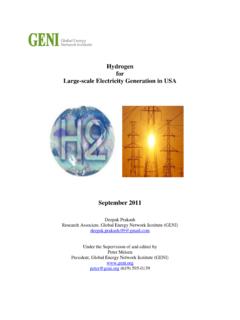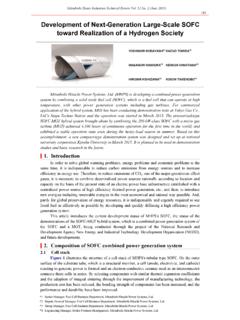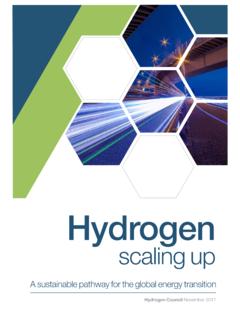Transcription of Power to Gas - flinkenergy.com
1 Power to Gas Opportunities for Greening the Natural Gas System Ken Dragoon, Flink Energy Consulting Study commissioned by NW Natural February, 2018 Flink Energy Consulting, 2018 2 Overleaf photo: Glomfjord, Norway 135 MW electrolyzer plant. 1953-1991. Courtesy Nel hydrogen . 3 Executive Summary Power to gas (PtG) is a means of using electricity and water as primary feedstocks to produce hydrogen or methane fuels capable of reducing the carbon footprint of delivered gas. If the Power is sourced from renewable resources such as excess wind or solar energy, the resulting gas is also carbon neutral.
2 This offers the potential to produce carbon neutral fuels when renewable resources are in good supply, leverage existing natural gas infrastructure for long-term and large-scale storage, and to use those fuels in existing Power plants to provide carbon neutral Power when renewable resources are in short supply. European policies recognize the vitally important need for long-term storage of renewable energy in the natural gas infrastructure. These policies have fostered dozens of demonstration projects that are increasingly becoming full-scale commercial applications. In the US, PtG is not generally recognized as energy storage at all, and is sometimes specifically excluded in electric system storage mandates.
3 Not only are unsupportive policies an impediment to PtG storage applications, competing electric energy storage media such as batteries and pumped hydro storage are prohibitively expensive for long-term bulk energy storage, and are hundreds of times more expensive than PtG storage in these applications. The technology for disassociating water into hydrogen and oxygen with electricity was discovered more than two hundred years ago, with utility scale electrolyzers in operation since at least as far back as 1953 (see cover photo). Despite the long history of the technology, it continues to develop due to renewed interest spurred by the rise in renewable resources that can create vast surpluses of electricity that need to be stored in large quantities over long periods of time.
4 The commercially-produced hydrogen available today is primarily derived from natural gas and is not carbon neutral. hydrogen produced by PtG technologies is not cost competitive with fossil-derived hydrogen or natural gas based on the energy value alone. The relatively high cost of natural gas in Europe, along with firm commitments to meeting carbon emission reduction goals, contributes to the greater level of interest in PtG there, while progress in the US has lagged significantly. Despite its higher cost in the US, PtG gas brings a host of other values that may make up for the cost difference and continued reductions in the cost of PtG technology will help make it increasingly more cost competitive.
5 hydrogen can be used directly in place of natural gas in many applications. Quantities of hydrogen can be mixed directly with natural gas in pipeline systems. There are important differences between hydrogen and natural gas that limit the fractional amount of hydrogen that can be injected into gas pipelines without requiring other changes ( , end user burner modifications). Through methanation, hydrogen combines with carbon dioxide to make methane, the primary constituent of natural gas. The resulting methane is freely interchangeable with natural gas. The Audi Car Company has been producing carbon neutral methane in a 6 MW plant in Germany since 2013 to fuel its compressed natural gas vehicles from a carbon neutral source.
6 While the importance of PtG to the success of renewable energy is broadly recognized and encouraged in Europe, the general lack of recognition among policy makers, renewable advocates, and regulators in the US remains a serious impediment. There are some 4 incentives for creating low carbon transportation fuels, but few other incentives. While the energy value of the produced gas is its primary value proposition, there are other valuable aspects of PtG that include strengthening the floor for wholesale electric market prices; providing fully dispatchable load capable of supplying grid balancing services ( ancillary services ) to Power grids, offering long-term storage of renewable energy; and reducing the carbon footprint of the nation s energy systems.
7 An important challenge for PtG is gaining the policy support necessary to enable the monetization of these important aspects of the technology. Development of PtG in North America can benefit from the rapid rise of PtG in Europe, where economies of scale and investments in research and development are causing improvements and cost reductions in the technology. Producing carbon neutral fuels from PtG can result in multiple benefits for the gas system, the electric Power system, and the environment. Among the potential benefits are: 1. Providing a viable approach to reaching carbon emission reduction goals.
8 2. Leveraging existing natural gas infrastructure for providing seasonal storage and distribution of renewable energy. 3. Reducing exposure to fuel price risk from volatile fossil-derived natural gas prices that may become subject to future carbon taxes or caps. 4. Expanding the market and reach of renewable Power sources beyond the electric Power grid to reduce carbon emissions from other energy sectors. 5. Potentially increasing disaster resilience by providing fuels from locally sourced renewable generation, without relying on interstate pipelines or roads. 6. Providing an economically feasible technology for bulk storage of renewable energy on a seasonal basis.
9 7. Adding flexible load to help manage both the variability and occasional large surpluses of renewable generation that occur on the electric Power system, potentially putting otherwise unusable Power to good use. It is likely that PtG has a bright future in achieving these benefits. A combination of policies and historically low natural gas prices are inhibiting its development in the US today, but as the pressure to reduce carbon emissions increases, and the cost of the technology improves with scale, there will be increasing opportunities for cost-effective PtG applications in the US. 5 Table of Contents Table of Contents.
10 5 Acknowledgments .. 6 hydrogen : the PtG Foundation .. 8 Producing hydrogen Through Water Electrolysis .. 9 Alkaline Electrolysis .. 9 Proton Exchange Membrane (PEM) Electrolysis .. 10 Solid Oxide Electrolysis (SOE) .. 11 Renewable Resources and PtG .. 12 Power System Energy Storage and PtG .. 14 Why it Matters .. 15 PtG Pathways .. 16 Electrolysis .. 17 Electrolyzer Technology Options .. 17 Electric Power Source .. 18 Disposition of Produced hydrogen .. 19 hydrogen Storage .. 20 Power Generation .. 22 Cost and Value Considerations .. 22 Water Use .. 24 Resiliency .. 24 Price Volatility Risk Management.





